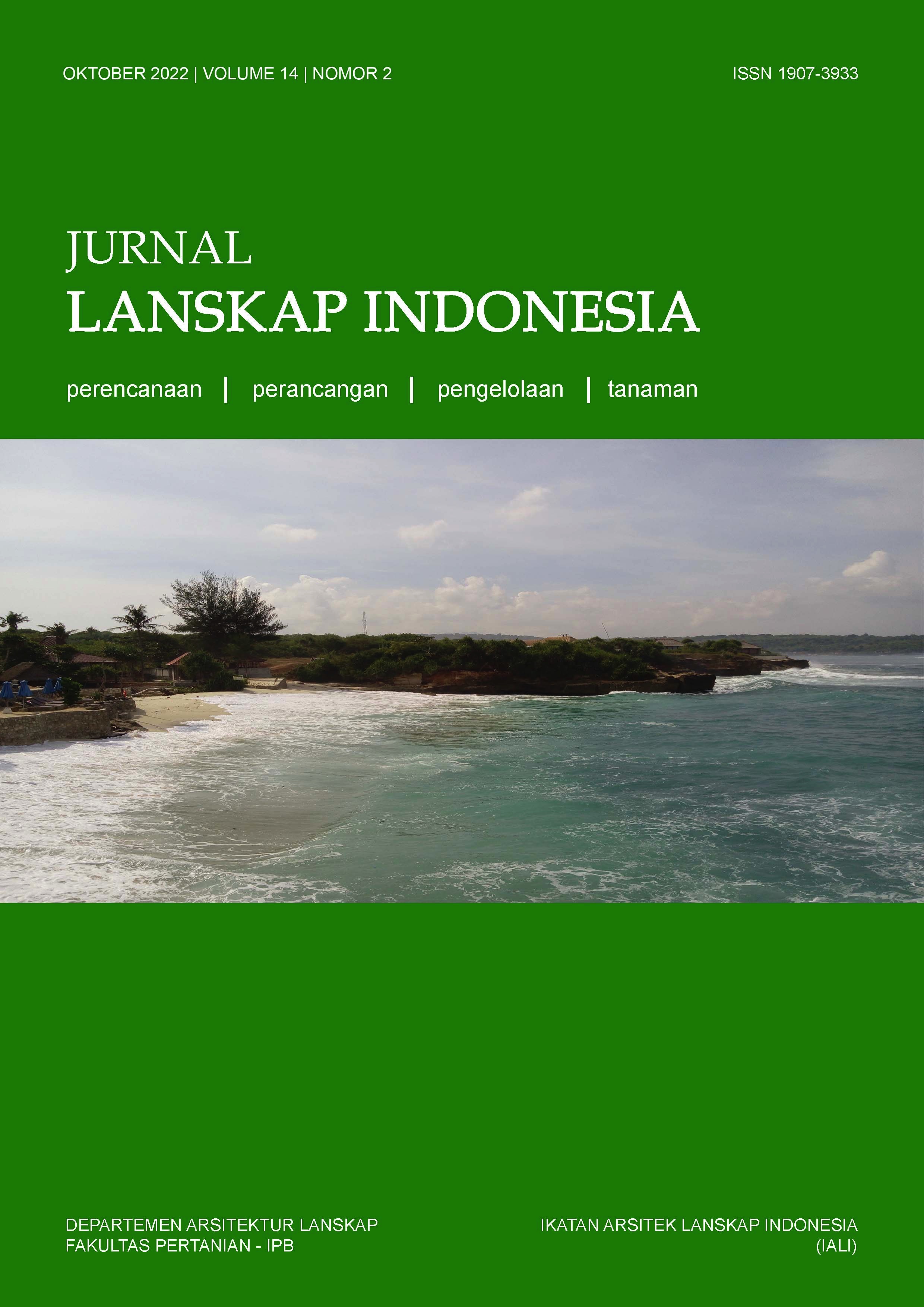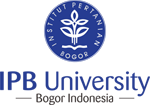Desain Lanskap Lapangan Golf Berbasis Fungsi Ekologis
Abstract
The golf course landscape is one form of sports area that can be a buffer zone between urban and rural areas. The golf course landscape functions as an area to absorb CO2 in the atmosphere, a windbreaker as well as a habitat for birds. The purpose of this research is to produce an ecologically based golf course landscape plan and design. The planning process includes site inventory surveys, site data analysis, design concept creation, golf course design development, and design development. Stages of site analysis using descriptive methods on the biophysical and physical components of the site. Meanwhile, the data analysis used the stored carbon analysis method is a allometric equation. The results show that in planning the golf course landscape, the landscape is divided into three spaces, namely the game area, maintenance area and service area. Then, landscape planning also determines the proposed contour, proposed drainage, and vegetation selection. The results of the planning are used to design the landscape, where the planting design is determined based on the composition of the vegetation that produces the highest stored carbon, which consists of grass, herbs, shrubs and trees. Then, the selection of vegetation that can bring birds and vegetation that can break the wind. The forms of planning and designing the golf course landscape are in the form of proposed contour drawings, proposed drainage, spatial concepts and three-dimensional visualization of the golf course landscape.
Downloads
References
Adjam, R. M. O., Renoat, E., 2017. Vegetasi Lanskap Jalan Sebagai Pereduksi Aliran Angin Di Kota Kupang. Jurnal Lanskap Indonesia, 9(1), pp.63-72.
Al-Hakim, A. H. 2014. Evaluasi Efektivitas Tanaman Dalam Mereduksi Polusi Berdasarkan Karakter Fisik Pohon Pada Jalur Hijau Jalan Pajajaran Bogor. Skripsi. Institut Pertanian Bogor
Alikodra, H. 1990. Teknik Pengelolaan Satwa Liar: Dalam Rangka Mempertahankan Keanekaragaman Hayati Indonesia. Bogor : IPB Press.
Arifin, H. S., Kaswanto, R. L., Nakagoshi, N. 2014. Low Carbon Society through Pekarangan, Traditional Agroforestry Practices in Java, Indonesia. In Designing Low Carbon Societies in Landscapes (pp. 129-143). Springer, Tokyo. In Designing Low Carbon Societies in Landscapes (Book).
Brown, S. 1997. Estimating biomass and biomass change of tropical forests: a primer (Vol. 134). Food & Agriculture Org.
Dahlan, E. N. 2007. Analisis Kebutuhan Hutan Kota sebagai Sink Gas CO2 Antropogenik dari Bahan Bakar Minyak dan Gas di Kota Bogor dengan Pendekatan Sistem Dinamik. Disertasi. Institut Pertanian Bogor.
Guntoro D., Purwoko B. S., Hurriyah R. G. 2007. Pertumbuhan, Serapan Hara, dan Kualitas Turfgrass pada Beberapa Dosis Pemberian Pupuk Hayati Mikoriza. Bul. Agron, (35), 142-147.
Hairiah, K., Rahayu, S., 2007. Petunjuk praktis Pengukuran karbon tersimpan di berbagai macam penggunaan lahan. World Agroforestry Centre, ICRAF Southeast Asia. Bogor. Indonesia. 77hal.
Handayani, A. D. 2015. Analisis Hubungan Keragaman Pohon Dengan Jumlah Jenis Burung Di Ruang Terbuka Hijau Taman Monas, Jakarta. Skripsi. Institut Pertanian Bogor.
Harker, D. Libby, G. Harker, K. Evans, S. Evans, Mark. 2000. Landscape Restoration Handbook : Second Edition. New York. Lewis Publisher.
Idilfitri, S., Nik, H. N. M. 2012. Peran Vegetasi untuk Habitat Burung di Taman Kota, Studi Kasus FRIM, Malaysia. Jurnal Procedia - Social and Behavioral Sciences, (68), 894 – 909.
Kaswanto, R. L. 2015. Land Suitability for Agrotourism through Agriculture, Tourism, Beautification and Amenity (ATBA) Method. Procedia Environmental Sciences, 24, 35-38. https://doi.org/10.1016/j.proenv.2015.03.006
Kaswanto, R. L., Filqisthi, T. A., Choliq, M. B. S. 2017. Revitalisasi Pekarangan Lanskap Perdesaan sebagai Penyedia Jasa Lanskap untuk Meningkatkan Kesejahteraan Masyarakat. Jurnal Lanskap Indonesia, 8(1), 50-60. https://doi.org/10.29244/jli.v8i1.17638
Klemme, M. 1995. A View from the Rough. Clock Tower Press.
Marsh, W. M. 1991. Landscape Planing, Environtmental Aplication. New Jersey : John Wiley & Sons Inc.
McCarty, L. B. 2018. Golf Turf Management. Florida. CRC Press.
McCoy, E. 2015. Drainage Systems for Golf Courses. Ohio: Ohio State University
National Meteorological Library & Archive Weather Observations Website (WOW). 2022. Beaufort-scale. https://www.metoffice.gov.uk/weather/guides/coast-and-sea/beaufort-scale (diakses 7 Agustus 2022).
Nick, C. Patton, A. J. & Law, Quincy. D. 2017. Fundamentals of Turfgrass Management Second Edition. New Jersey: Wiley.
Peraturan Menteri Pekerjaan Umum. 2008. Nomor 05/PRT/M/2008. Tentang Pedoman Penyediaan dan Pemanfaatan Ruang Terbuka Hijau di Kawasan Perkotaan. Jakarta: Kementerian Pekerjaan Umum Republik Indonesia.
Prastiyo, Y. B., Kaswanto, R. L., Arifin, H. S. 2018. Plants Production of Agroforestry System in Ciliwung Riparian Landscape, Bogor Municipality. IOP Conference Series: Earth and Environmental Science, 179(1), 12013. https://doi.org/10.1088/1755-1315/179/1/012013
Sajekti, A. 2009. Metode Kerja Bangunan Sipil. Yogyakarta: Graha Ilmu.
Slattery, B. E, Reshetiloff, K., Zwicker S. M. 2003. Native Plants for Wildlife Habitat and Conservation Landscaping. Washington D.C: U.S. Fish & Wildlife Service.
Smith, W. G. 2005. Teaching Golf Course Design In A Landscape Architecture Curriculum. Thesis. Athens :University of Georgia.
Sukmawijaya, I. G., Astiningsih, A. A. M., Kohdrata, N. 2019. Konsep Pertanaman Landskap Berdasarkan Karakteristik Pertamanan Bali pada Lanskap New Kuta Golf. Jurnal Arsitektur Lanskap, 5 (1), 1-8.
Sutrisno, A. J., Hermanto. 2020. Perancangan dan Pembangunan Taman Apotek Hidup pada Lanskap Industri, Kabupaten Kudus. Jurnal Lanskap Indonesia, 12(1), 8-12.
Wahyuni, S., Syartinilia, Mulyani, Y. A. 2018. Efektivitas Ruang Terbuka Hijau sebagai Habitat Burung di Kota Bogor dan Sekitarnya. Jurnal Lanskap Indonesia, 10(1), 29-36. https://doi.org/10.29244/jli.v10i1.21395
Wibawa, I. N., Sutrisno, A. J. 2022. Penerapan Konsep Walkable Campus pada Perancangan Jalur Pedestrian Kampus Diponegoro UKSW. Jurnal Lanskap Indonesia, 14(1), pp.22-35.
Copyright (c) 2022 Syach Fahreza, Alfred Jansen Sutrisno

This work is licensed under a Creative Commons Attribution 4.0 International License.
This journal permits and encourages authors to post items submitted to the journal on personal websites or institutional repositories both prior to and after publication, while providing bibliographic details that credit, if applicable, its publication in this journal. However, after the article is submitted and published in this journal, it is fully copyrighted by the Jurnal Lanskap Indonesia or JLI. If excerpts from other copyrighted works are included, the author must obtain written permission from the copyright owner and give credit to the source in the article. Then, the writer or reader is allowed to copy, share, and redistribute articles/material in any form. But it must still include the appropriate source and credit because the article in this journal is licensed by Creative Commons Attribution 4.0 International License (CC BY 4.0).
I. Proposed Policy for Journals That Offer Open Access
Authors who publish with this journal agree to the following terms:
- Authors retain copyright and grant the journal right of first publication with the work simultaneously licensed under a Creative Commons Attribution License that allows others to share the work with an acknowledgement of the work's authorship and initial publication in this journal.
- Authors are able to enter into separate, additional contractual arrangements for the non-exclusive distribution of the journal's published version of the work (e.g., post it to an institutional repository or publish it in a book), with an acknowledgement of its initial publication in this journal.
- Authors are permitted and encouraged to post their work online (e.g., in institutional repositories or on their website) prior to and during the submission process, as it can lead to productive exchanges, as well as earlier and greater citation of published work (See The Effect of Open Access).
II. Proposed Policy for Journals That Offer Delayed Open Access
Authors who publish with this journal agree to the following terms:
- Authors retain copyright and grant the journal right of first publication, with the work after publication simultaneously licensed under a Creative Commons Attribution License that allows others to share the work with an acknowledgement of the work's authorship and initial publication in this journal.
- Authors are able to enter into separate, additional contractual arrangements for the non-exclusive distribution of the journal's published version of the work (e.g., post it to an institutional repository or publish it in a book), with an acknowledgement of its initial publication in this journal.
- Authors are permitted and encouraged to post their work online (e.g., in institutional repositories or on their website) prior to and during the submission process, as it can lead to productive exchanges, as well as earlier and greater citation of published work (See The Effect of Open Access).



























